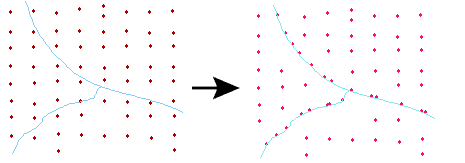Features that may have Candidate features snapped to them. Arcs are snapped as linear features, and ellipses are snapped as polygonal features.
Takes a series of features that match the input specification and performs snapping on the features that lie within the specified tolerance from other features that match the input specification. You can use this transformer to perform cleaning operations on data during a translation.
The difference between the AnchoredSnapper and the Snapper is that anchor features are considered to be accurate and consequently do not move.
Features that may have Candidate features snapped to them. Arcs are snapped as linear features, and ellipses are snapped as polygonal features.
Features that may be snapped to Anchor features. Arcs are snapped as linear features, and ellipses are snapped as polygonal features.
Candidates whose geometry is changed by the transformer.
Candidates that leave the transformer without being changed.
The anchors that were used during snapping. If a candidate was snapped to a point along the segment of an anchor, a new node is inserted into the anchor’s geometry.
If you select Group By attributes, only those features with the same Group By attribute values will be snapped together.
Note: How parallel processing works with FME: see About Parallel Processing for detailed information.
This parameter determines whether or not the transformer should perform the work across parallel processes. If it is enabled, a process will be launched for each group specified by the Group By parameter.
For example, on a quad-core machine, minimal parallelism will result in two simultaneous FME processes. Extreme parallelism on an 8-core machine would result in 16 simultaneous processes.
You can experiment with this feature and view the information in the Windows Task Manager and the Workbench Log window.
No: This is the default behavior. Processing will only occur in this transformer once all input is present.
By Group: This transformer will process input groups in order. Changes of the value of the Group By parameter on the input stream will trigger batch processing on the currently accumulating group. This will improve overall speed if groups are large/complex, but could cause undesired behavior if input groups are not truly ordered.
Using Ordered input can provide performance gains in some scenarios, however, it is not always preferable, or even possible. Consider the following when using it, with both one- and two-input transformers.
Single Datasets/Feature Types: Are generally the optimal candidates for Ordered processing. If you know that the dataset is correctly ordered by the Group By attribute, using Input is Ordered By can improve performance, depending on the size and complexity of the data.
If the input is coming from a database, using ORDER BY in a SQL statement to have the database pre-order the data can be an extremely effective way to improve performance. Consider using a Database Readers with a SQL statement, or the SQLCreator transformer.
Multiple Datasets/Feature Types: Since all features matching a Group By value need to arrive before any features (of any feature type or dataset) belonging to the next group, using Ordering with multiple feature types is more complicated than processing a single feature type.
Multiple feature types and features from multiple datasets will not generally naturally occur in the correct order.
One approach is to send all features through a Sorter, sorting on the expected Group By attribute. The Sorter is a feature-holding transformer, collecting all input features, performing the sort, and then releasing them all. They can then be sent through an appropriate filter (TestFilter, AttributeFilter, GeometryFilter, or others), which are not feature-holding, and will release the features one at a time to the transformer using Input is Ordered By, now in the expected order.
The processing overhead of sorting and filtering may negate the performance gains you will get from using Input is Ordered By. In this case, using Group By without using Input is Ordered By may be the equivalent and simpler approach.
In all cases when using Input is Ordered By, if you are not sure that the incoming features are properly ordered, they should be sorted (if a single feature type), or sorted and then filtered (for more than one feature or geometry type).
As with many scenarios, testing different approaches in your workspace with your data is the only definitive way to identify performance gains.
When Snapping Type is End Point Snapping:
When Snapping Type is Vertex Snapping:
When this parameter is set to Segment Snapping:
Snapping Distance specifies the distance, in ground units, that the snapping occurs between features.
When Snapping Type is Segment Snapping, this transformer performs data cleaning that is meant to improve the robustness of the results when they are used in other algorithms by ensuring that no two vertices in the snapped output are within tolerance of each other.
If Tolerance is set to Automatic, a tolerance will automatically be calculated for the cleaning operation, based on the size of the inputs. Otherwise, a custom tolerance may be used.
This parameter applies only when the end point of a feature is being snapped.

FME Professional Edition and above
Using a set of menu options, transformer parameters can be assigned by referencing other elements in the workspace. More advanced functions, such as an advanced editor and an arithmetic editor, are also available in some transformers. To access a menu of these options, click  beside the applicable parameter. For more information, see Transformer Parameter Menu Options.
beside the applicable parameter. For more information, see Transformer Parameter Menu Options.
Search for samples and information about this transformer on the FME Knowledge Center.
Associated FME function or factory: SnappingFactory
Tags Keywords: FixedSnapper BaseSnapper